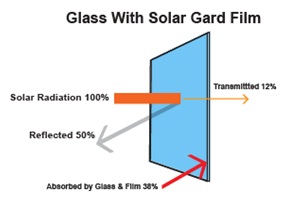The Best Energy Efficient Windows
The amount of energy that escapes through American windows every winter is equivalent to all the oil that flows through the Alaska pipelines each year. If you apply Window film it interrupts the transfer of this energy by reflecting the energy back, therefore preventing heat from escaping or sunlight penetrating through windows when applied to home windows or automobiles.
Facts:
●About nine times as much heat escapes from your house through a single-pane window as through a typical insulated wall.
●Even during a mild winter, you can lose as much energy through one single-pane window as a 40-watt light bulb uses running seven hours a day, 365 days a year.
●A double-pane window retains twice as much heat as a single-pane window.
●Newly developed window coating (thin films that are sprayed or baked on the windows during the manufacturing process) reflect heat back into the house but lets the sunlight through easily. Windows with these coatings are called Low E or Spectrally Selective. They cut energy loss significantly compared to windows without coating.
●The energy lost through windows can account for 25% of heating costs, and up to 30% of cooling costs.
Ways to Save Energy
Install storm windows.
●If you feel thrifty and don’t mind plastic on your windows, you can make effective storm windows by tacking clear polyethylene plastic over the outside of your windows.
●Glass storm windows are more effective, but they will save some energy and increase your comfort. Some types are attached in the fall and removed in the spring; others can stay year-round and open just like the regular window.
Install new windows
●Specially made double-paned windows are now available either with insulating airspace between the two panes or filled with a gas, such as argon. In climates with colder winters, these can save a lot of energy.
●”Low E” windows are more costly, but even greater efficiency can be achieved with them.
●Frames are important. Standard aluminum frames leak twice as much heat around the edges of the glass as do the best wooden, vinyl, or fiberglass frames.
If you must have aluminum frames, make sure they have “thermal breaks” (rubber gaskets between inner and outer pieces).
Get Reflective
 ●Window film sticks onto the inside of windows to block out some of the sun’s rays in the summer and keep your house from overheating. They can easily be applied to existing windows. They also keep out the winter sun, so they make the most sense in areas where summer cooling is a bigger concern than winter heating.
●Window film sticks onto the inside of windows to block out some of the sun’s rays in the summer and keep your house from overheating. They can easily be applied to existing windows. They also keep out the winter sun, so they make the most sense in areas where summer cooling is a bigger concern than winter heating.
●A wide variety of other products are available to bounce those incoming sunbeams back to the sky and keep them from heating up your house. There are reflective screens- essentially a mirrored surface with holes cut in it so you can see out. There are louvered screens, like Venetian blinds, whose slant intercepts much of the sun but little of the view. And there are fiberglass screens, which are like regular bug screens, but thicker and whiter to reflect the sunlight back outside.
Results
If just 100,000 homeowners installed one storm window, they would save some 35 million cubic feet of natural gas every year, and they’d keep more than 4 million pounds of carbon dioxide out of the air. If 1% of the household in the U.S. put on three storm windows, it would save one oil tanker full of oil every year.
Information provided by The Earth●Works Group.
Energy Efficient Window Film
The movement or transfer of heat from a region of higher temperature to one of cooler temperature is called heat transfer. The transfer of heat always flows from hot to cold.
No heat will transfer if there is no difference in temperature.
There are three types of heat transfer: Radiation, Conduction, and Convection. For window film, radiation is the most important method of heat transfer because it moves infrared waves. Therefore, we refer to solar energy as solar radiation.
Energy Saving Window Tint
Solar energy through a window is transferred or transmitted by infrared waves. Radiant energy is converted to heat when it strikes people or objects. If you block the transfer of this energy, you keep it from turning into heat because it never strikes an object. Window film interrupts the transfer of this energy by reflecting the energy back.
 Transmission is basically the percentage of Solar energy (UV + Visible Light + Near Infrared) that can pass through a window. Reflection is the ratio of solar energy reflected back to the source, expressed as a percentage. Absorption is the percentage of solar energy absorbed to that of the total solar energy.
Transmission is basically the percentage of Solar energy (UV + Visible Light + Near Infrared) that can pass through a window. Reflection is the ratio of solar energy reflected back to the source, expressed as a percentage. Absorption is the percentage of solar energy absorbed to that of the total solar energy.
With solar window film installed on the inside of a window, the proportions are changed dramatically, with reflected energy and absorption increases. This corresponds to a reduction in solar heat transmitted inside the room or the automobile. The properties of the window film dramatically influence how and in what way transmission, reflection, and absorption change.
How lowering the temperature saves energy.
Only a few degrees in temperature reduction can have up to a 25% reduction in cooling costs, due to the laws of thermodynamics. It requires considerable amounts of energy to remove heat from a room through air conditioning. During peak summer times in the middle of the day, loads on air conditioning systems can be reduced enough to turn off entire units or to install a less costly system.
 Solar Gard window film reflects significant solar energy while absorbing another portion of the energy. The result is that the amount of solar radiation transmitted inside the room is considerably less. Specs will vary depending on the Solar Gard window film selected.
Solar Gard window film reflects significant solar energy while absorbing another portion of the energy. The result is that the amount of solar radiation transmitted inside the room is considerably less. Specs will vary depending on the Solar Gard window film selected.
In addition to the energy-saving benefits, solar window film can increase thermal comfort, reduce glare, while at the same time rejecting 99% of the UV radiation reducing fading and the risk of skin cancer.
Receive a tax credit for installing window film
The Energy Policy Act of 2005 provides Federal tax credits for consumers who make certain energy-efficient improvements to their homes. This bill extends tax credits for energy-efficient home improvements, such as energy-saving window film. The Act provides a 2011 residential tax credit for consumers through the end of 2011.
Under section 25C of the Internal Revenue Code (I.R.C.), homeowners can receive a 10 percent credit on the costs of “qualified energy efficiency improvements,” including Solar Gard solar control window film on windows, doors, and skylights. This tax credit applies only to improvements made to a primary residence from Jan. 1, 2011, through Dec. 31, 2011. A tax credit is generally more valuable than an equivalent tax deduction because a tax credit reduces your tax dollar-for-dollar, while a deduction only removes a percentage of the tax that is owed. If you can itemize energy-related purchases on your federal income tax form, it will lower the total amount of tax you owe the government.
Homeowners can receive a 10 percent credit on the cost of the window film, up to $500. Installation costs do not apply, only the cost of the film.
Save On Your Energy Bills Now
Cooling costs related to the heat gained through windows can make up about 40 percent of a home’s summer utility bill for homes with air conditioning. Solar control window film rejects up to 80 percent of the total solar energy, which helps lower your energy consumption. And the energy savings benefits go on year after year, long after you have received the tax credit.
And the benefits don’t stop there. In addition to energy savings all year long, window films also can:
- Improve your comfort by eliminating hot spots and maintaining interior temperatures
- Help protect your family from UV exposure, which can help prevent certain forms of skin cancer
- Reduce glare
- Reduce fading of furnishings and interiors
How to Receive Credit
Complete the 2014 version of the IRS form 5695 and file 2014 Income Tax Returns by April 15, 2015. Maintain copies of the dealer invoice and the manufacturer’s certification statement for your records. If you are audited, you will need to provide these documents to the IRS.
Tax forms will be available for download from Energy Star Tax Credit or the IRS website at http://www.irs.gov/ towards the end of 2011.
Locating a Solar Gard Dealer
For professionally installed window film, visit the Find a Dealer section of our website.

